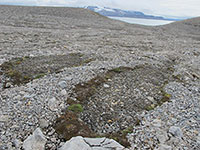Graduate Students Munoz and Campo Blog from Norway
In Photo: Yuribia Munoz (left) and Jennifer Campo on field trip to visit glacial deposits on the island of Spitsbergen. Students were trained in the use of rifles to protect themselves from polar bears that roam the island.Two University of Houston graduate students in geology, Yuribia Munoz and Jennifer Campo, spent the summer as exchange students in Svalbard, Norway, studying Arctic glacial geology. Svalbard is a group of islands in the Arctic Ocean located north of mainland Europe, midway between mainland Norway and the North Pole.
To keep friends, family and the Department of Earth and Atmospheric Sciences up to date with their activities, they blogged about the experience.
Munoz and Campo’s graduate studies are focusing on sedimentation in fjords and glacial geomorphology in Antarctica. Their mentor is UH assistant professor Julia Wellner.
Glacial Field Work
“Taking a class in Svalbard tremendously impacted my understanding of glacial environments,” said Munoz, who is working on her Ph.D. “The classes were mostly field based, so we were outside looking at the rocks and the sediment, something that is not possible in Antarctica because it is much colder and difficult to get to.”
For Campo, the experience fit well with the work she is doing for her master’s thesis.
“Svalbard gave me real-world examples of how to see and interpret glacial sequences,” she said. “All of it is integral to interpreting past ice sheet dynamics, which is the focus of my thesis.”
As part of the exchange program, Munoz and Campo took the course, Arctic Terrestrial Quaternary Stratigraphy. The course included an eight-day field excursion on a research vessel to Spitsbergen, a heavily glaciated island.

Frost Circles“In seminar, I enjoyed learning about permafrost environments. When we got into the field, I was able to actually see all the permafrost processes at work,” Campo said. “Frost circles were my favorite, and I devoted a small section to them in the blog, under the Kongsfjordhallet post.”
Munoz, who has done research aboard vessels in the Antarctic, appreciated the opportunity to “see” features of glaciers. “Looking at the geologic features close to a glacier was very interesting,” she said. “In the Antarctic, we usually see these features only by analyzing geophysical data since they are covered by hundreds of meters of water and sediment. In Svalbard, we were able to walk on them.”
Cultural + Educational Exchange
The participants consisted of 14 graduate students from seven countries (Iceland, U.S., Germany, Norway, Denmark, Canada and Poland) and three professors from the University of Iceland, Lund University in Sweden and the University of Norway at Svalbard, who were studying various aspects of the geology of the island.
“One of the most memorable things about the program was being surrounded by so many rich cultures at once, with one common interest in science and ice,” Campo said.
In addition to the field work and seminars, Munoz and Campo had other novel experiences including a sun that never set, frigid temperatures, rainy days, minimal vegetation (no trees, only lichens, mosses and small flowers), and keeping a sharp eye out for polar bears that range over the island.
“It was wonderful to meet students from different nationalities, who live in different countries, speak a different language, and love geology as much as we do,” Munoz said. “We had long conversations about their countries, hobbies, traditions, family, universities, and of course, food.”
An agreement signed in 2012 by UH and University of Stavanger officials laid the groundwork for this exchange program. Through the program, UH graduate or undergraduate geology and geophysics students can take courses at University of Stavanger (where all classes are taught in English) for one or two semesters, and Norwegian students can come to the U.S. and take courses at UH.
Munoz and Campo describe their Svalbard experiences in their blogs posted at: http://eassvalbard.blogspot.com
- Kathy Major, College of Natural Sciences and Mathematics |

